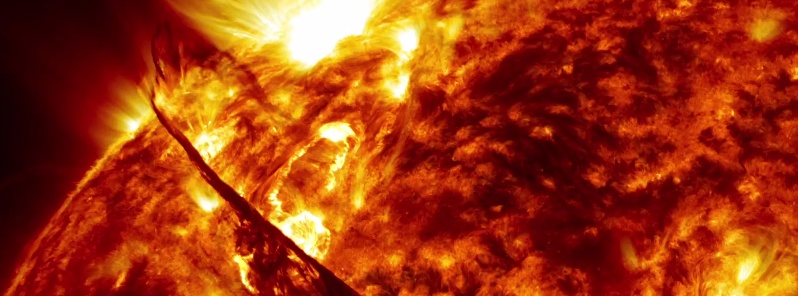New videos released in honor of SDO’s 5th anniversary

February 11, 2015 marks five years in space for NASA's Solar Dynamics Observatory, which provides incredibly detailed images of the whole Sun 24 hours a day.
Capturing an image more than once per second, SDO has provided an unprecedentedly clear picture of how massive explosions on the Sun grow and erupt ever since its launch on February 11, 2010. The imagery is also captivating, allowing one to watch the constant ballet of solar material through the Sun's atmosphere.
In honor of SDO's fifth anniversary, NASA has released a video showcasing highlights from the last five years of Sun watching. Watch the movie to see giant clouds of solar material hurled out into space, the dance of giant loops hovering in the corona, and huge sunspots growing and shrinking on the Sun's surface.

The imagery is an example of the kind of data that SDO provides to scientists. By watching the Sun in different wavelengths – and therefore different temperatures – scientists can watch how material courses through the corona, which holds clues to what causes eruptions on the Sun, what heats the Sun's atmosphere up to 1 000 times hotter than its surface, and why the Sun's magnetic fields are constantly on the move.
Five years into its mission, SDO continues to send back tantalizing imagery to incite scientists' curiosity.
For example, in late 2014, SDO captured imagery of the largest sunspot seen since 1995 (Region 2192) as well as a torrent of intense solar flares.
Solar flares are bursts of light, energy and X-rays. They can occur by themselves or can be accompanied by what's called a Coronal Mass Ejection, or CME, in which a giant cloud of solar material erupts off the Sun, achieves escape velocity and heads off into space. In this case, the Sun produced only flares and no CMEs, which, while not unheard of, is somewhat unusual for flares of that size. Scientists are looking at that data now to see if they can determine what circumstances might have led to flares eruptions alone. You can see the first rotation video of this region here.
The second video released in honor of SDO's 5th anniversary is a 3-minute time-lapse video which captures one frame every 8 hours starting when data became available in June 2010 and finishing February 8, 2015. The different colors represent the various wavelengths (sometimes blended, sometimes alone) in which SDO observes the Sun.


Videos and featured image: SDO

Commenting rules and guidelines
We value the thoughts and opinions of our readers and welcome healthy discussions on our website. In order to maintain a respectful and positive community, we ask that all commenters follow these rules:
We reserve the right to remove any comments that violate these rules. By commenting on our website, you agree to abide by these guidelines. Thank you for helping to create a positive and welcoming environment for all.